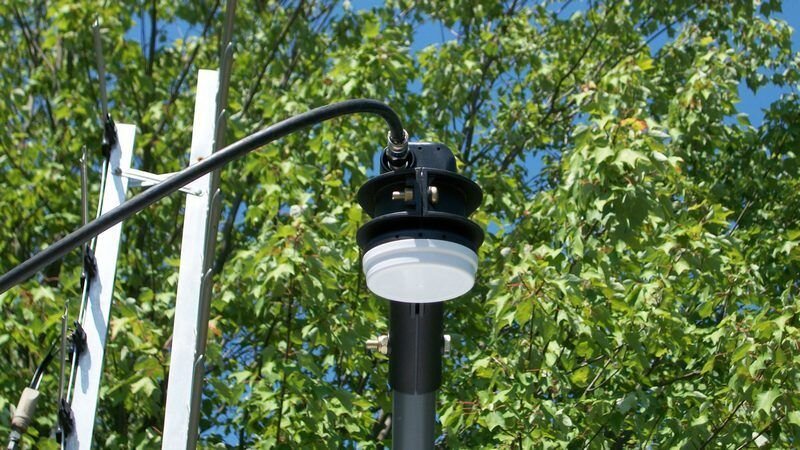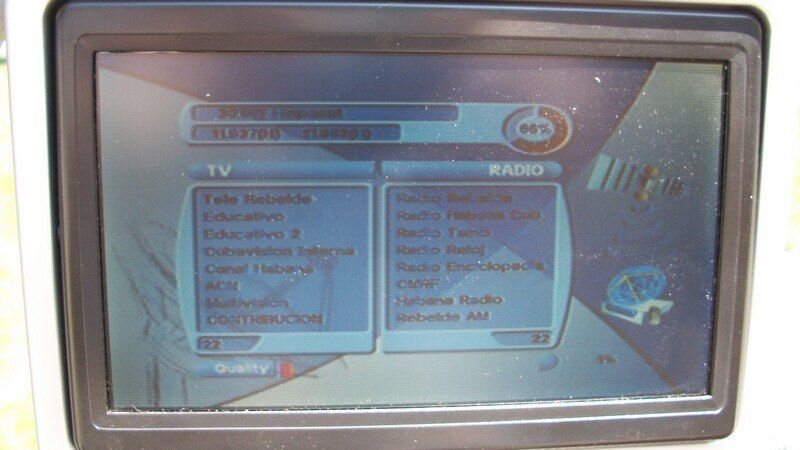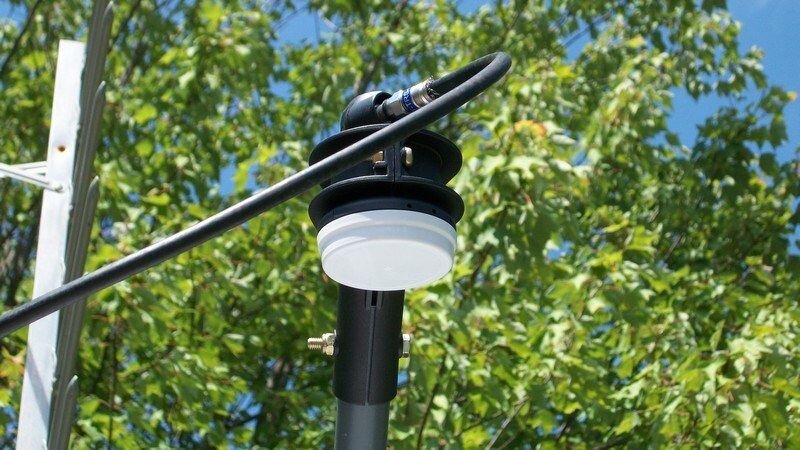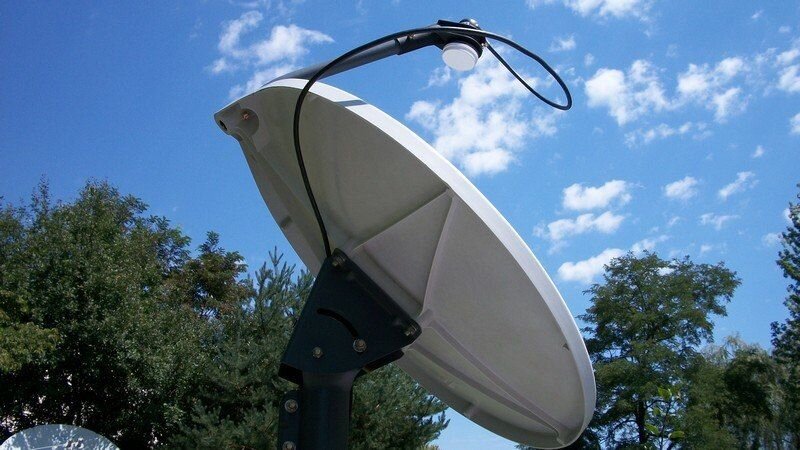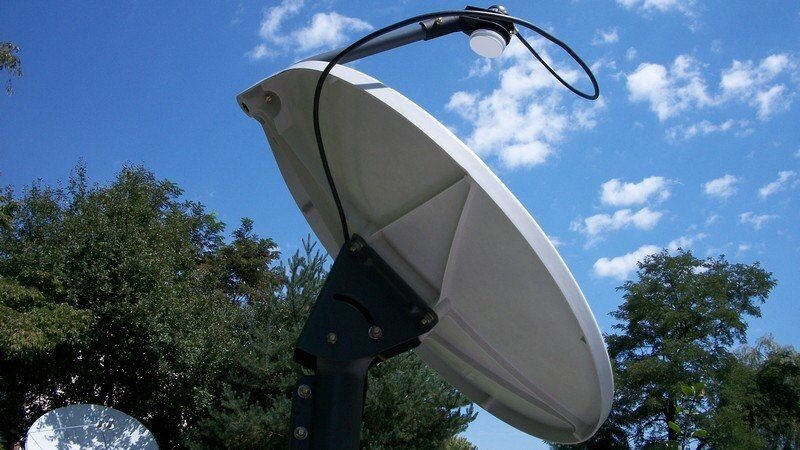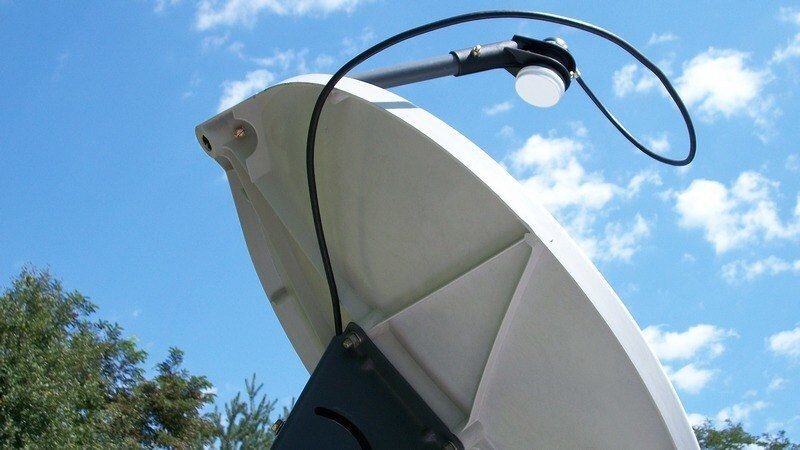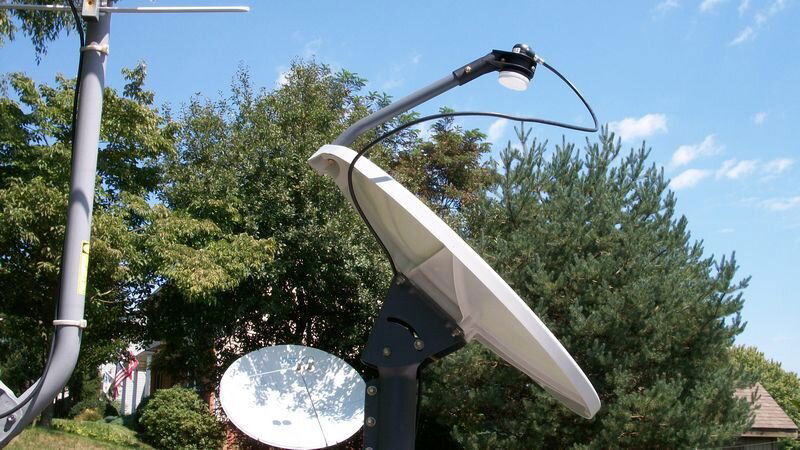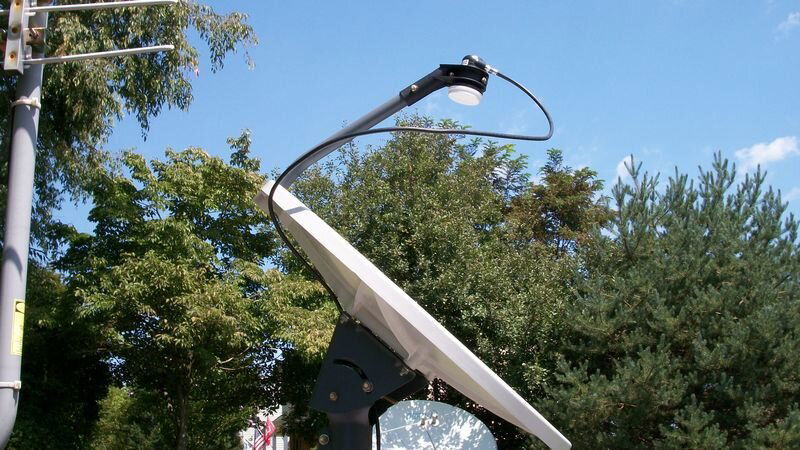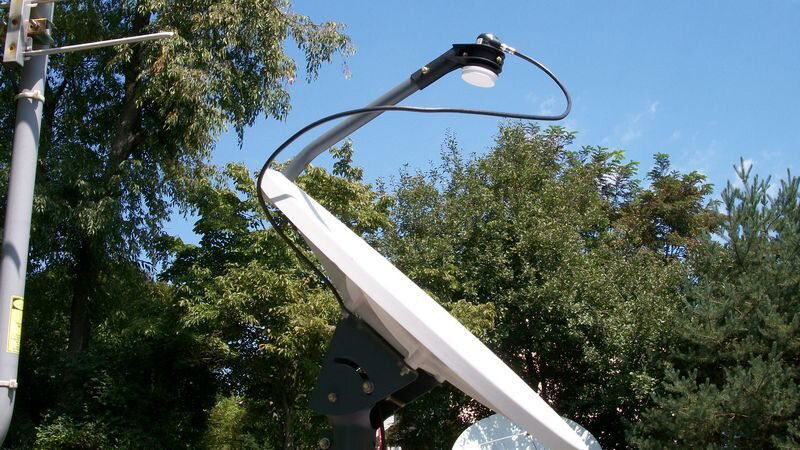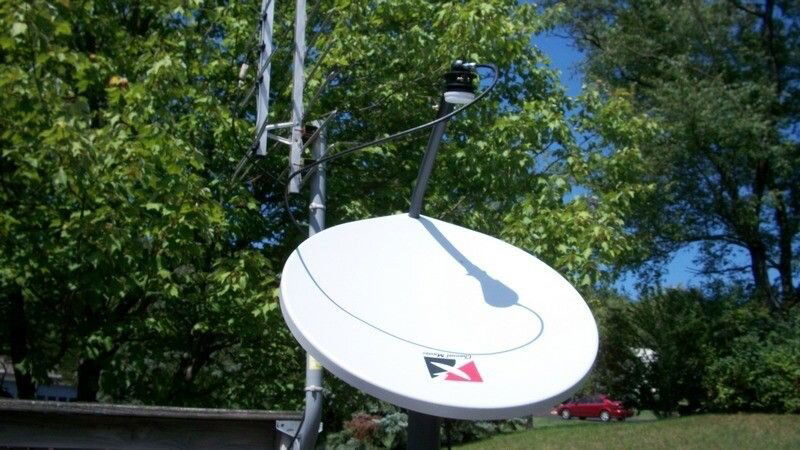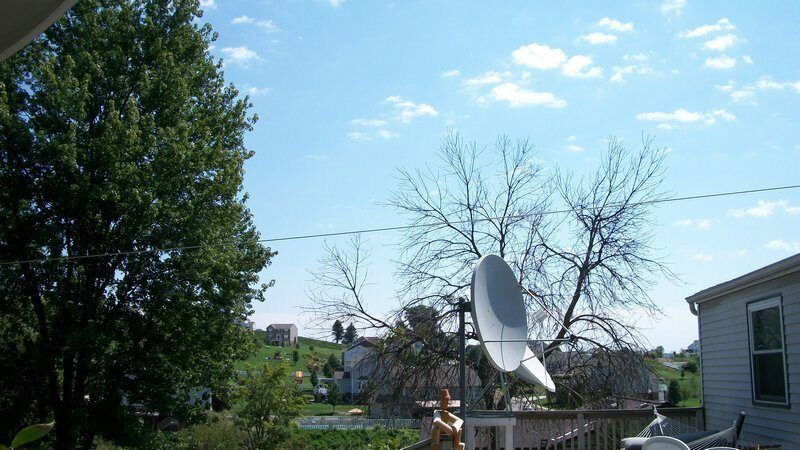What are you using to aim the dish? Whenever I need to aim the dish, I hook up my Traxis DBS4000 receiver and easy find LNB. I pick a strong transponder, and the LNB has a light on it that turns from red to green whenever it's pointed properly. Cubavision is a strong transponder that I've used before. It's so easy, and I've never had any problems with it. I have my dish mounted on a pole on my roof, and I can get 15W no problem.
Hispasat Day
- Thread starter PopcornNMore
- Start date
- Latest activity Latest activity:
- Replies 46
- Views 12K
You are using an out of date browser. It may not display this or other websites correctly.
You should upgrade or use an alternative browser.
You should upgrade or use an alternative browser.
- Status
- Please reply by conversation.
Set the LNBF skew BEFORE aiming a fixed dish.
With a 40° skew, it would be almost impossible to get a signal lock with a 0° setting.
As seen in the attached photos a total of 22 channels scanned in on Hispasat having the LNBF set at 0 degrees.
Attachments
Peak your CNN signal (especially skew) and then move the dish a touch lower and 30w should show up. U r almost there!
That's a nice little dish looks like brand new!
This is exactly what I did to receive Hispasat. I scanned in 10 transponders resulting in 55 channels. Lowest signal quality is 69 and highest signal quality is 76.
I bought this dish new on EBay roughly 8 years ago and never used it until this weekend.
Attached are pictures of my 60cm Channel Master dish adjusted at 30.0W Hispasat. Receiving 55 channels on 10 transponders with the signal quality ranging from 69 to 76. Cubavision has a signal quality of 72.
The first photo is the view directly in front of the dish.
The first photo is the view directly in front of the dish.
Attachments
I just performed a blindscan using the Optibox Anaconda HD receiver and it found 13 transponders and 61 channels. Not bad for a 24" dish.
Time will tell if having access to Cubavision is worth having a dedicated dish for Hispasat, but at least I can cross off two items from my FTA to do list.
Time will tell if having access to Cubavision is worth having a dedicated dish for Hispasat, but at least I can cross off two items from my FTA to do list.
Attachments
-
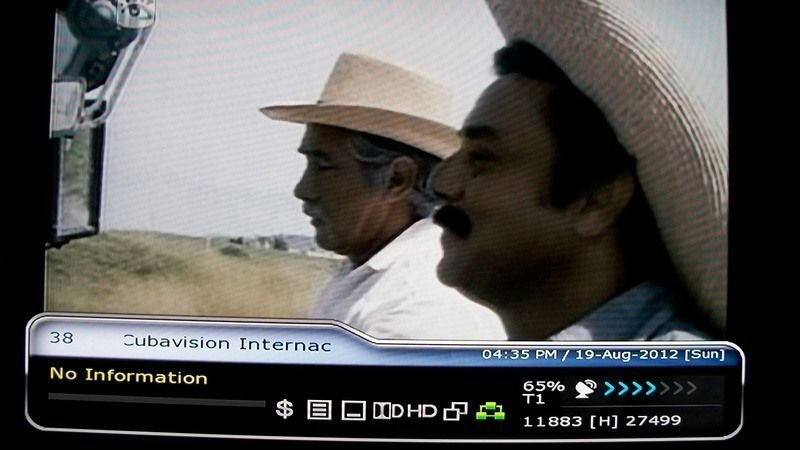 136.JPG46.3 KB · Views: 180
136.JPG46.3 KB · Views: 180 -
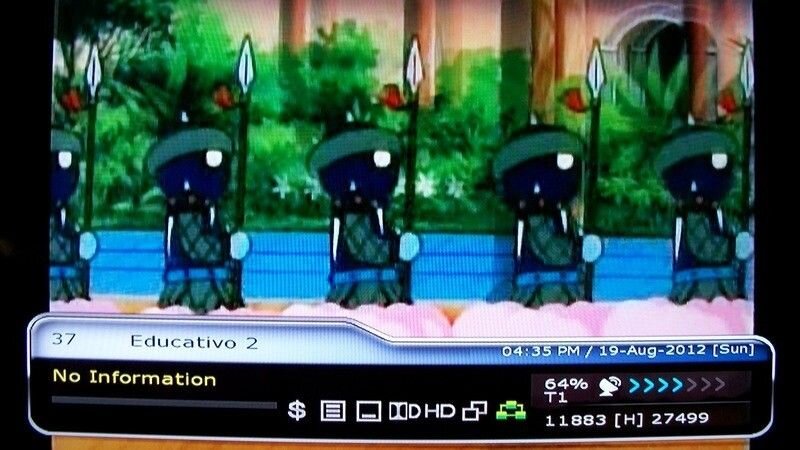 131.JPG68.3 KB · Views: 161
131.JPG68.3 KB · Views: 161 -
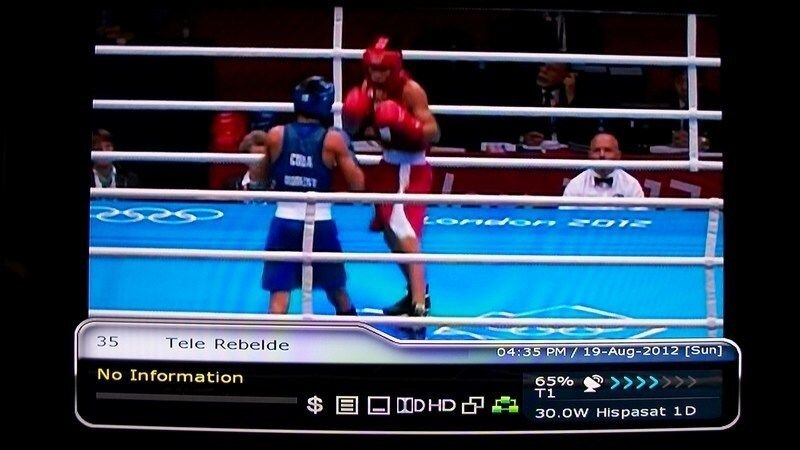 129.JPG55.9 KB · Views: 182
129.JPG55.9 KB · Views: 182 -
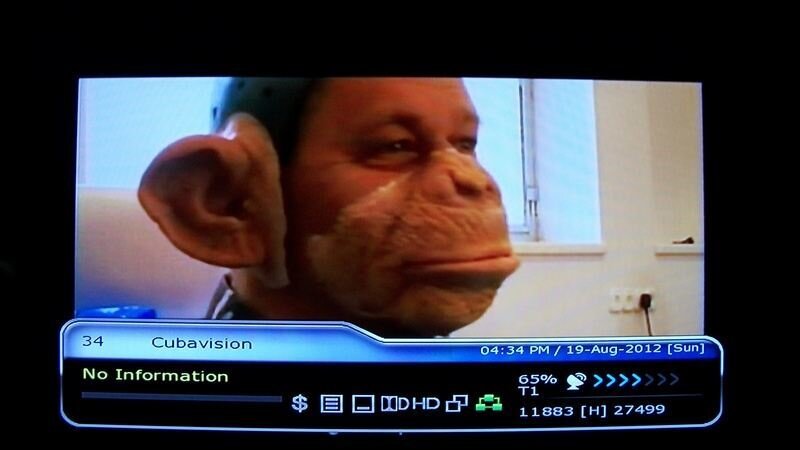 122.JPG34.3 KB · Views: 162
122.JPG34.3 KB · Views: 162 -
 118.JPG42.7 KB · Views: 170
118.JPG42.7 KB · Views: 170 -
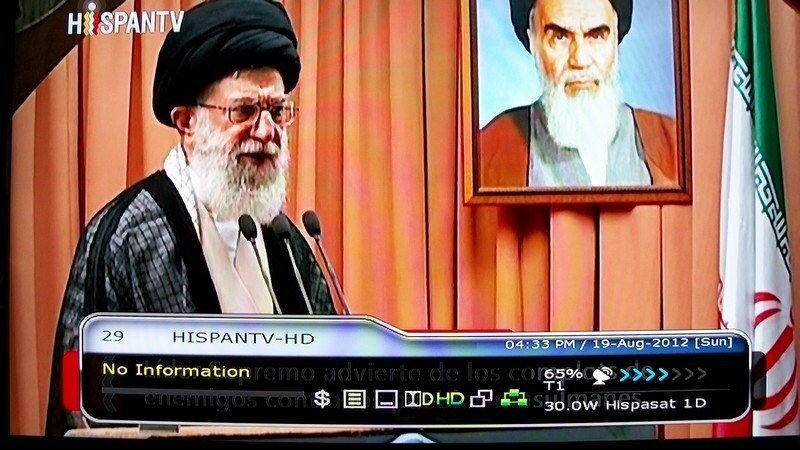 113.JPG80 KB · Views: 175
113.JPG80 KB · Views: 175 -
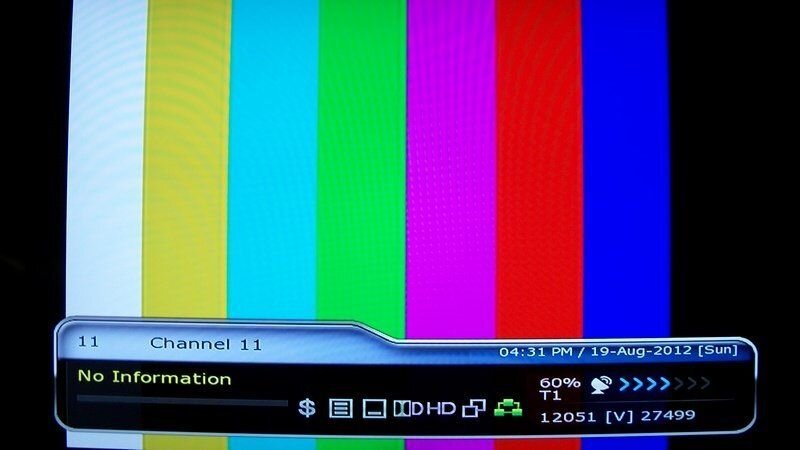 105.JPG36.1 KB · Views: 155
105.JPG36.1 KB · Views: 155 -
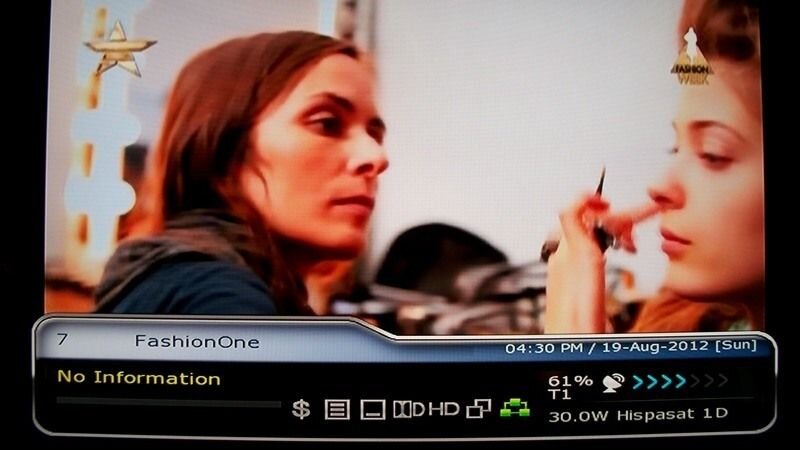 095.JPG44.3 KB · Views: 180
095.JPG44.3 KB · Views: 180 -
 081.JPG61.8 KB · Views: 149
081.JPG61.8 KB · Views: 149 -
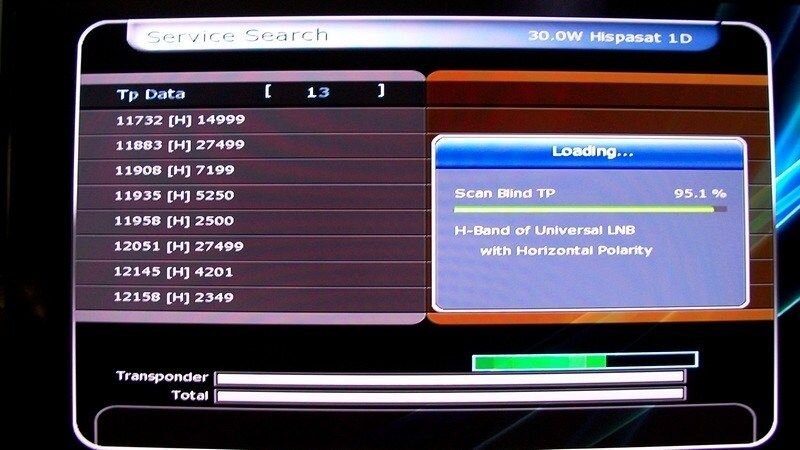 066.JPG62.6 KB · Views: 158
066.JPG62.6 KB · Views: 158 -
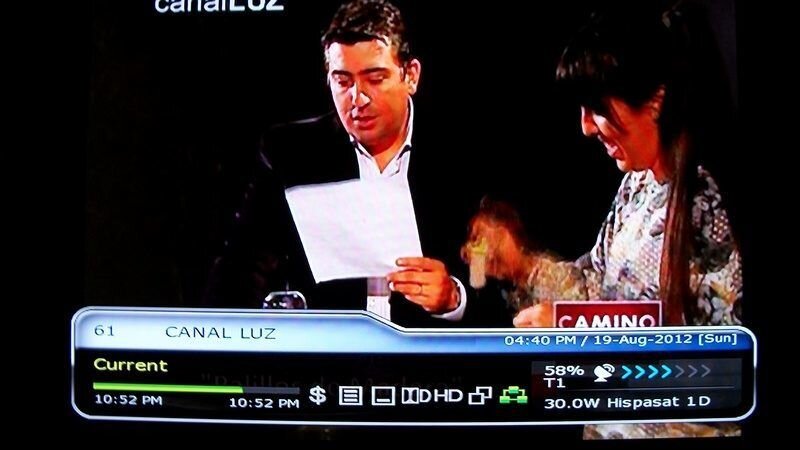 161.JPG45.4 KB · Views: 156
161.JPG45.4 KB · Views: 156 -
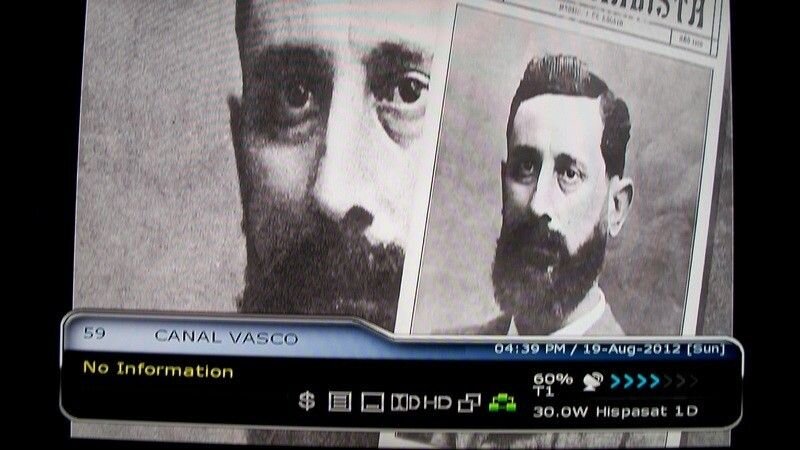 157.JPG58.7 KB · Views: 185
157.JPG58.7 KB · Views: 185 -
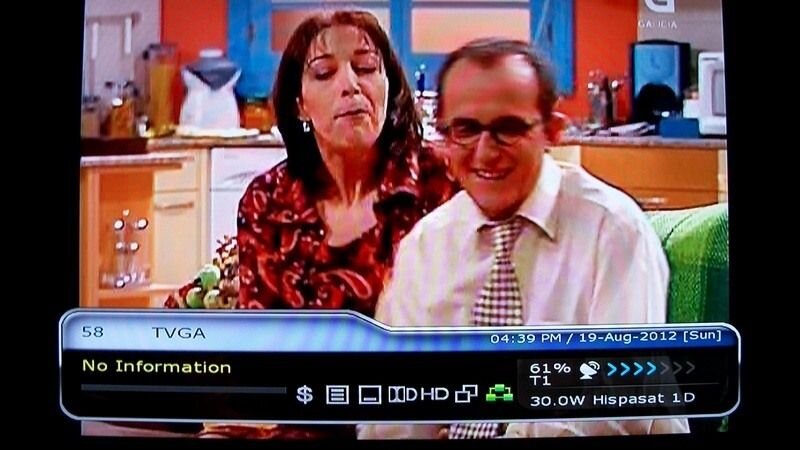 156.JPG58.4 KB · Views: 166
156.JPG58.4 KB · Views: 166 -
 152.JPG37.8 KB · Views: 175
152.JPG37.8 KB · Views: 175 -
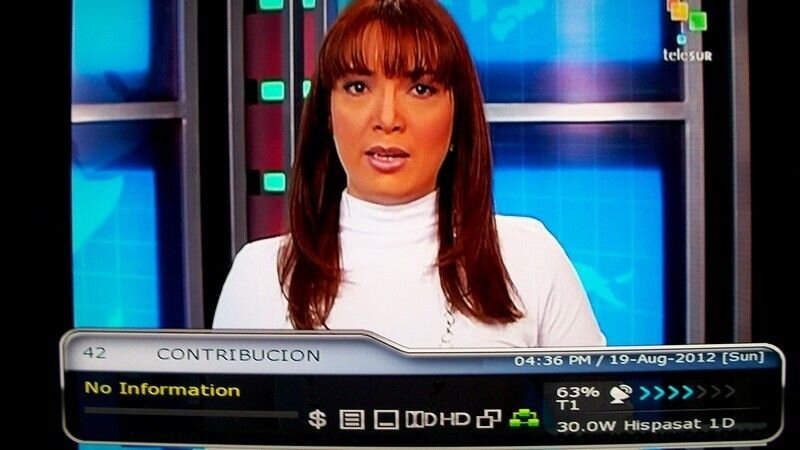 142.JPG53.3 KB · Views: 188
142.JPG53.3 KB · Views: 188
Last edited:
So just for my knowledge, what does the elevation scale read(with the dish inverted) on 30W?
Just want to see if my hunched calculation is correct.
Can you believe between 70 and 75? Perhaps with the dish inverted you adjust the elevation 21 degrees in the opposite direction? When I had the elevation adjusted yesterday to 45 degrees (24 offset of dish + 21 Hispasat elevation) I spent hours and received nothing.
This morning I decided to raise the elevation as you and others suggested and I received the CNN signal within minutes. I then turned the dish and received Hispasat shortly after and then adjusted the azimuth, elevation and LNBF skew for the highest signal quality.
I currently have the skew markings on the LNBF facing towards the top of the dish to prevent water from entering the coax. I believe the H transponders I received are V and the V are H. This is probably because I turned the LNBF 40 degrees in the wrong direction and / or because the skew markings are facing towards the top of the dish. As long as I'm receiving Cubavision I don't really care for now until I get time to correct.
Whatever works... as long as you are aware the skew being 45 degrees off simply inverts the H/V TPs, you are good to go. Makes no difference other than when adding TPs manually or using preset lists. Amazing how many tPs you are getting with a 24" dish on that bird... I might have to re-purpose my bird bath dish back to FTA service (It's an old Bell dish). 
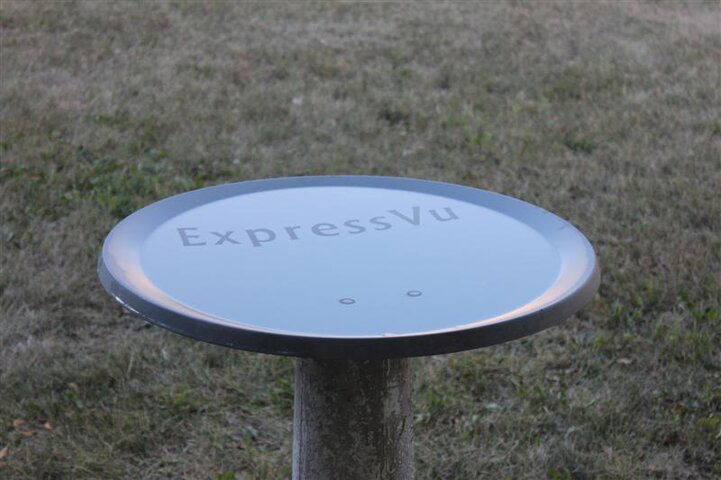
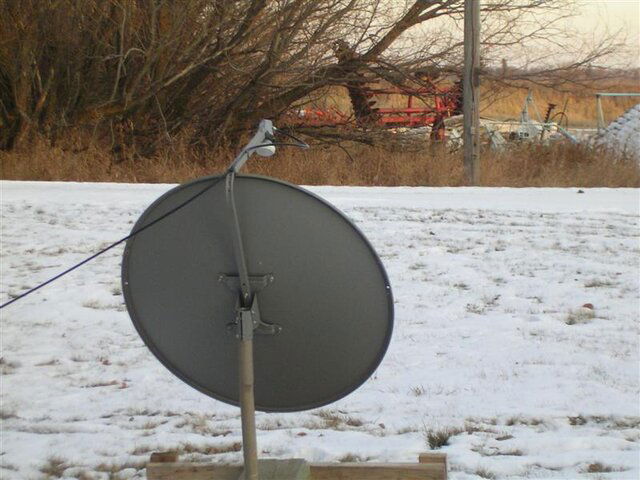
first one is the birdbath, second is my inverted dish (last winter).


first one is the birdbath, second is my inverted dish (last winter).
Last edited:
Whatever works... as long as you are aware the skew being 45 degrees off simply inverts the H/V TPs, you are good to go. Makes no difference other than when adding TPs manually or using preset lists. Amazing how many tPs you are getting with a 24" dish on that bird... I might have to re-purpose my bird bath dish back to FTA service (It's an old Bell dish).View attachment 80292View attachment 80294
first one is the birdbath, second is my inverted dish (last winter).
I like the bird bath idea! I probably have a space in the garage I can do the same thing with. Do you see birds using it?
I have your second dish pictured, but the rear mount is currently being used on my 120cm Channel Master dish along with a piece of thick plywood.
I used a Dish 500 for several months on 30w but upgraded because in heavy rain and snow you would lose most channels except for the Cuban networks. Even with the larger Wildblue dish I still lose Telecaribe and the other South American channels. I would be curious to see how your 24" dish performs in bad weather on these channels.
I used a Dish 500 for several months on 30w but upgraded because in heavy rain and snow you would lose most channels except for the Cuban networks. Even with the larger Wildblue dish I still lose Telecaribe and the other South American channels. I would be curious to see how your 24" dish performs in bad weather on these channels.
I'll keep you posted.
why are we doing an inverted dish? Are there trees involves?
21 elevation isnt that bad and would be easier to put the dish on "normally" unless there are trees involved
Does it really help if the trees obscure the "borehole" from sat to dish? After reversing the dish, its bowl stays roughly in the same place, maybe it is higher by just a few inches only. Cheers, polgyver
Hispasat day...
Hi there.I live in Austin TX and I got the Hispasat signal very strong(over 80% quality)The sight between my dish and the satellite goes through several trees.My dish is a motorized offset WS 90 cm with a Lexium 7000 receiver and an standard KU LNBF.The problem is if I want to move the system to another satellite I get no signal because the elevation angle for Hispasat doesn't match with any other satellite.I definitelly left the WS 90 dish on fixed position only for Hisapasat and I use a 180 Sadun motorized to get the rest of the satellites arch.
Hi there.I live in Austin TX and I got the Hispasat signal very strong(over 80% quality)The sight between my dish and the satellite goes through several trees.My dish is a motorized offset WS 90 cm with a Lexium 7000 receiver and an standard KU LNBF.The problem is if I want to move the system to another satellite I get no signal because the elevation angle for Hispasat doesn't match with any other satellite.I definitelly left the WS 90 dish on fixed position only for Hisapasat and I use a 180 Sadun motorized to get the rest of the satellites arch.
I want to better understand the elevation of an inverted dish. I currently have the dish aligned to receive Hispasat which in my area has a 21 degree elevation. If the dish was installed normally the elevation scale on the mount would be adjusted to 21 degrees. With the dish inverted I first read that you set the elevation to the offset of the dish (24 degrees) + the satellite elevation (21 degrees) which is 45 degrees. With the elevation scale on the mount adjusted to 45 degrees I received nothing.
I also read that you double the offset of the dish (24 + 24 = 48 degrees) and subtract the satellite offset (21 degrees) which would be 27 degrees. My elevation scale on my dish is currently set to roughly 73 degrees to receive Hispasat. Why 73 degrees? I'm thinking perhaps you adjust the elevation scale to be 27 degrees from the bottom of the scale (100 degrees) which would put you at the 73 degree mark the dish is currently set at.
If my dish was installed normally and set to 21 degrees it would be facing directly at some trees, but set to 73 degrees it is aimed way above the tree line. I know the satellite position doesn't move, so does it hit a different area of the dish if the dish is inverted?
Now that I think about it I placed my angle locator onto the front of the dish and adjusted to 45 degrees which enabled me to receive Hispasat. So the answer is you probably go by the angle locator on the front of the dish rather than the elevation scale on the mount to determine the correct elevation.
I also read that you double the offset of the dish (24 + 24 = 48 degrees) and subtract the satellite offset (21 degrees) which would be 27 degrees. My elevation scale on my dish is currently set to roughly 73 degrees to receive Hispasat. Why 73 degrees? I'm thinking perhaps you adjust the elevation scale to be 27 degrees from the bottom of the scale (100 degrees) which would put you at the 73 degree mark the dish is currently set at.
If my dish was installed normally and set to 21 degrees it would be facing directly at some trees, but set to 73 degrees it is aimed way above the tree line. I know the satellite position doesn't move, so does it hit a different area of the dish if the dish is inverted?
Now that I think about it I placed my angle locator onto the front of the dish and adjusted to 45 degrees which enabled me to receive Hispasat. So the answer is you probably go by the angle locator on the front of the dish rather than the elevation scale on the mount to determine the correct elevation.
Hi Dan...At Hispasat satellite you can watch channels from Spain,Argentina,Cuba, Colombia,Uruguay,Kwait,Syria,Press TV,Iraq,Palestinian,Fashion channelPortugal,TV Marti from Miami,Fl and some other arabian channels.
In theory, an inverted dish angle would be calculated by adding the satellite elevation angle with the offset angle. This sum would be adjustment reading of the vertical plane angle on the face of the dish. If you wanted to aim at 21 degrees above the horizon with an inverted 24 degree offset dish, set the dish face angle to 45 degrees (21 + 24 = 45 degrees).
If you wish to use the elevation scale on the back of the dish, add the 24 degree offset to this calculation. (45 + 24 = 69 degrees).
If you wish to use the elevation scale on the back of the dish, add the 24 degree offset to this calculation. (45 + 24 = 69 degrees).
Last edited:
In theory, an inverted dish angle would be calculated by adding the satellite elevation angle with the offset angle. This sum would be adjustment reading of the vertical plane angle on the face of the dish. If you wanted to aim at 21 degrees above the horizon with an inverted 24 degree offset dish, set the dish face angle to 45 degrees (21 + 24 = 45 degrees).
If you wish to use the elevation scale on the back of the dish, add the 24 degree offset to this calculation. (45 + 24 = 69 degrees).
To achieve this using my 3ABN dish, I had to use the "B" end of the mounting bracket, as the "A" end of the bracket wouldn't allowing the dish the get to above 50° elevation.
In theory, an inverted dish angle would be calculated by adding the satellite elevation angle with the offset angle. This sum would be adjustment reading of the vertical plane angle on the face of the dish. If you wanted to aim at 21 degrees above the horizon with an inverted 24 degree offset dish, set the dish face angle to 45 degrees (21 + 24 = 45 degrees).
If you wish to use the elevation scale on the back of the dish, add the 24 degree offset to this calculation. (45 + 24 = 69 degrees).
Thank you Brian! That helped clear up what I was seeing this weekend.
When using a microHD and a SG-2100, what would cause an "Out of range" error when trying to access the Hispasat satellite...Does it have to do with setting the limit switches in the SG-2100 or some other things.
When scanning the satellite, it comes up with TPs that are all different from the Hispasat satellite channel list. There seems to be a clear path/view to the Hispasat, and the dish seems to point somewhere in that direction.
Thank You.
When scanning the satellite, it comes up with TPs that are all different from the Hispasat satellite channel list. There seems to be a clear path/view to the Hispasat, and the dish seems to point somewhere in that direction.
Thank You.
Last edited:
- Status
- Please reply by conversation.
Similar threads
- Replies
- 8
- Views
- 739
- Replies
- 3
- Views
- 1K
- Replies
- 1
- Views
- 1K
- Replies
- 14
- Views
- 3K
- Replies
- 4
- Views
- 2K


